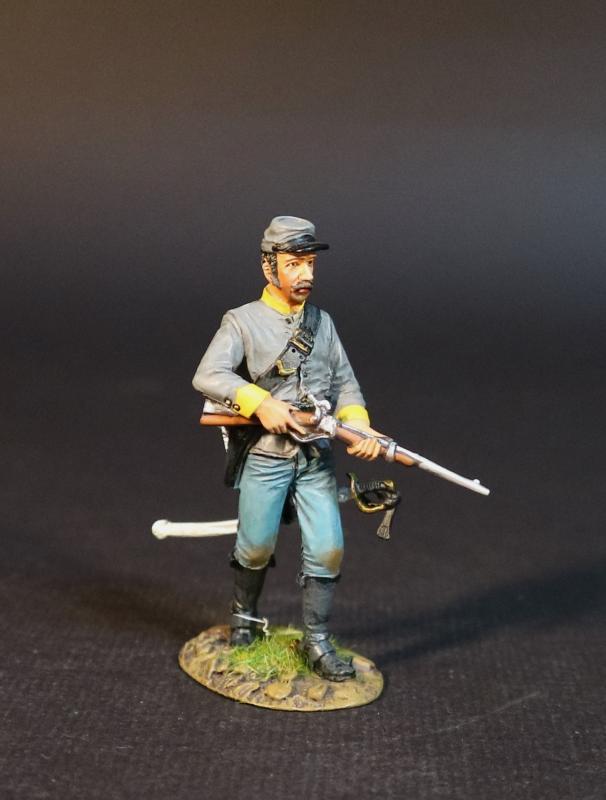Dismounted Confederate Cavalryman Standing Readying Rifle, Cavalry Division, The Army of Northern Virginia, The Battle of Brandy Station, June 9th, 1863, The American Civil War, 1861-1865--single figure
$49.00
Item Number: CSBS-23
Dismounted Confederate Cavalryman Standing Readying Rifle, Cavalry Division, The Army of Northern Virginia, The Battle of Brandy Station, June 9th, 1863, The American Civil War, 1861-1865--single figure
The Battle of Brandy Station, June 9th, 1863
The Battle of Brandy Station, also called the Battle of Fleetwood Hill, was the largest predominantly cavalry engagement of the American Civil War, as well as the largest ever to take place on American soil. It was fought on June 9th, 1863, around Brandy Station, Virginia at the beginning of the Gettysburg Campaign by the Union cavalry under Maj.Gen. Alfred Pleasonton against Maj. Gen. J.E.B. Stuart’s Confederate cavalry.
After an all day fight in which fortunes changed repeatedly, the Federals retired without discovering Gen. Robert E. Lee’s infantry camped near Culpeper. This battle marked the end of the Confederate cavalry’s dominance in the East.
From this point in the war the Federal cavalry gained strength and confidence.
The Battle saw nine thousand Union cavalrymen and three thousand Union infantry clash with ten thousand Confederate horsemen. The fighting lasted for roughly twelve hours and covered dozens of square miles.
Unknown to the Confederates, 12,000 Union men had massed on the other side of the Rappahannock River.
Maj. Gen. Alfred Pleasonton, commanding the Cavalry Corps of the Army of The Potomac, had organized his combined armed forces into two wings, under Brig. Gen. John Buford and David McMurtrie Gregg, augmented by infantry brigades from the V Corps.
Buford’s wing, accompanied by Pleasonton, consisted of hus own 1st Cavalry Division, a reserve brigade led by Maj. Charles J. Whiting, and an infantry brigade of 3,000 men under Brig. Gen. Adelbert Ames.
Gregg’s wing was the 2nd Cavalry Division, led by Col. Alfred N. Duffie, the 3rd Cavalry Division led by Gregg, and an infantry brigade under Brig. Gen. David A. Russell.
The commander of the Army of the Potomac, Maj. Gen. Joseph Hooker, interpreted the enemy’s cavalry presence around Culpeper to be indicative of preparations for a raid of his army’s supply lines. In reaction to this, he ordered Pleasonton’s force on a “spoiling raid”, to “disperse and destroy” the Confederates.
Pleasonton’s attack plan called for a two-pronged thrust at the enemy. Buford’s wing would cross the river at Beverly’s Ford, two miles northeast of Brandy Station, at the same time, Gregg would cross at Kelly’s Ford, six miles downstream to the southeast.
Pleasonton anticipated that the Southern cavalry would be caught in a double envelopment, surprised, outnumbered, and beaten.
He was, however, unaware of the precise disposition of the enemy and he incorrectly assumed that his force was substantially larger than the Confederates he faced.
The increased accuracy and range of rifled firearms and artillery had brought an end to battle cavalry as used by Frederick the great, Napoleon and as recently as in the wars of the Crimea and Italy.
Cavalry had learned to fight mounted and dismounted, in effect becoming dragoons.
Cavalry, normally did not now participate in battles, operating instead in front of and on the edges of armies. They could be scouts, raiders, escorts for wagon trains and mounted generals. The glory years of the horse soldier were almost over. In less than a hundred years, they would be replaced by aircraft, motorized, and mechanized units.
When a cavalry regiment dismounted, one trooper out of every four held the reins of his own horse and three of his comrades.
A typical cavalry charge against cavalry was a relatively rare occurrence, usually with one side or the other breaking and bolting before contact. If hand to hand combat ensued, the fighting was confusing, vicious and protracted. If one side committed reserve squadrons to the fray, they often carried the day.
Released in JANUARY 2024.

